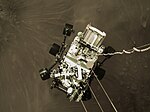astro.wikisort.org - Asteroid
2016 AJ193, also known as 2010 KV134, is a near-Earth object and potentially hazardous asteroid of the Apollo group, approximately 1.4 kilometres (0.87 mi) in diameter. It was discovered on 17 May 2010 by the Wide-field Infrared Survey Explorer (WISE) satellite, but was lost until it was reobserved on 16 January 2016.[5][2] With an observation arc over 11 years, 2016 AJ193 has a well-determined orbit and trajectory through the year 2086.[3] The asteroid's orbit is only potentially hazardous on a time scale of thousands of years.[6][7]
 Doppler-delay radar images of 2016 AJ193 from the Goldstone Radar on 22 August 2021 | |
| Discovery[1][2] | |
|---|---|
| Discovered by | WISE |
| Discovery site | Low Earth orbit |
| Discovery date | 17 May 2010 (first observation only) |
| Designations | |
MPC designation | 2016 AJ193 |
Alternative designations | 2010 KV134 |
Minor planet category | NEO · Apollo · PHA[3] |
| Orbital characteristics[3] | |
| Epoch 1 July 2020 (JD 2459396.5) | |
| Uncertainty parameter 0 | |
| Observation arc | 11.51 yr (4,204 days) |
| Earliest precovery date | 16 February 2010 |
| Aphelion | 5.931 AU |
| Perihelion | 0.5999 AU |
Semi-major axis | 3.265 AU |
| Eccentricity | 0.8163 |
Orbital period (sidereal) | 5.90 yr (2,155 days) |
Mean anomaly | 344.173° |
Mean motion | 0° 10m 1.359s / day |
| Inclination | 22.570° |
Longitude of ascending node | 331.285° |
Argument of perihelion | 81.996° |
| Earth MOID | 0.01553 AU (2,323,000 km) |
| Physical characteristics | |
Mean diameter | 1.374±0.403 km[3] |
Synodic rotation period | 3.508±0.001 h[4] |
Geometric albedo | 0.031±0.031[3] |
Absolute magnitude (H) | 18.99[3][1] |
On 21 August 2021, the asteroid safely made a close approach to Earth from a distance of 0.0229 AU (3.43 million km; 2.13 million mi), or 8.92 lunar distances (LD). During closest approach, 2016 AJ193 reached a peak apparent magnitude of 14, visible to ground-based observers with telescope apertures of at least 20 cm (8 in).[4][6] It is the largest asteroid that approached within 10 LD (3.8 million km; 2.4 million mi) of Earth in 2021.[8]

References
- "2016 AJ193". Minor Planet Center. International Astronomical Union. Retrieved 3 September 2021.
- "MPEC 2020-B104 : 2016 AJ193". Minor Planet Electronic Circular. Minor Planet Center. 23 January 2020. Retrieved 3 September 2021.
- "JPL Small-Body Database Browser: (2016 AJ193)" (2021-08-21 last obs.). Jet Propulsion Laboratory. Retrieved 3 September 2021.
- Benner, Lance A. M. "Goldstone Radar Observations Planning: 2016 AJ193 and 2011 UC292". Jet Propulsion Laboratory. California Institute of Technology. Retrieved 3 September 2021.
- "MPEC 2016-B28 : 2016 AJ193". Minor Planet Electronic Circular. Minor Planet Center. 18 January 2016. Retrieved 3 September 2021.
- Irizarry, Ezzie (20 August 2021). "Heads Up! Close Asteroid Pass August 21". EarthSky. Retrieved 3 September 2021.
- O'Neill, Ian J.; Fox, Karen; Handal, Joshua (3 September 2021). "Planetary Radar Observes 1,000th Near-Earth Asteroid Since 1968". Jet Propulsion Laboratory. NASA. Retrieved 3 September 2021.
- "NEO Earth Close Approaches". Center for Near Earth Object Studies. Jet Propulsion Laboratory. Retrieved 3 March 2021.
External links
- Goldstone Radar Observations Planning: 2016 AJ193 and 2011 UC292, Lance A. M. Benner, Jet Propulsion Laboratory
- Radar Reveals the Surface of Asteroid 2016 AJ193, Jet Propulsion Laboratory, 3 September 2021
- 2016 AJ193 at NeoDyS-2, Near Earth Objects—Dynamic Site
- Ephemeris · Obs prediction · Orbital info · MOID · Proper elements · Obs info · Close · Physical info · NEOCC
- 2016 AJ193 at the JPL Small-Body Database
Другой контент может иметь иную лицензию. Перед использованием материалов сайта WikiSort.org внимательно изучите правила лицензирования конкретных элементов наполнения сайта.
WikiSort.org - проект по пересортировке и дополнению контента Википедии


